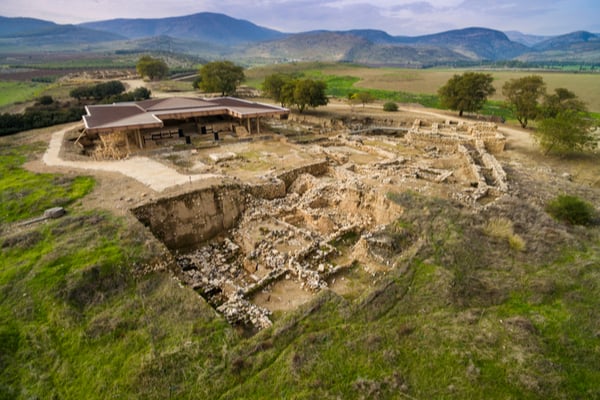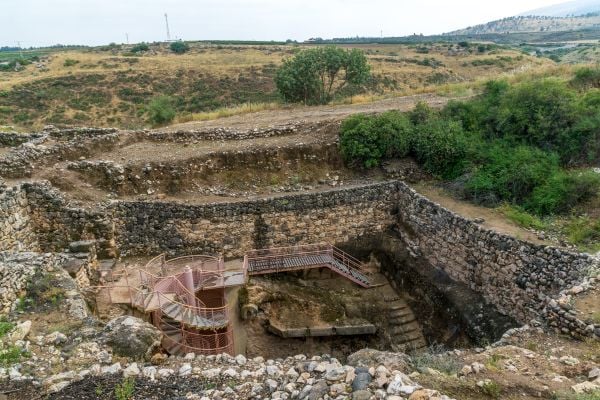Hazor was the most powerful Canaanite city when Joshua conquered the Holy Land.
By Nosson Shulman, Licensed Tour Guide
“Joshua…Conquered Hazor and struck it’s king by the sword…Hazor…The Leader of all those kingdoms. (Only) Hazor he burned in fire… All of the others…Israel did not burn.” (Joshua 11: 10-13)
“King Solomon (re-built) …. Hazor.” (1 Kings: 9:15)
Biblical Hazor is one of the premier archeological sites in Israel. Many of the most epic events of the Bible took place here, and even UNESCO listed it as a world heritage site in 2005. Such a world class treasure must surely be on the “must-see” portion of itineraries, right?
The shocking truth is that few tourists (even veteran tourists who are Bible literate) have ever even heard of it. Despite my vast knowledge of Hazor, I have only guided here twice, both times to tourists who annually visit Israel, and only because I recommended it to them. On the first visit, tears streamed down my tourist’s cheeks when she realized that she was literally standing in a place where G-d led His people in battle.
When people read about the “Land of Canaan” in the Bible, they think of a large kingdom encompassing most of modern Israel, but actually Canaan was made up of city states with their own kings who were often at war with each other.
According to the Bible, Hazor was the most powerful Canaanite city state. In fact, excavations have shown Hazor to have been the largest tel (archeological site) in Israel at 820 dunams (or over 200 acres). To put this into perspective, David’s Jerusalem was only 61 dunams (15 acres).
The Al Armana letters (a series of ancient letters written between Pharaoh and other Kings) was discovered in 1887 by an Egyptian peasant. These letters back up the Biblical account of Hazor being the most powerful Canaanite city state.
Egypt controlled the land of Canaan (at the same time the Hebrews were enslaved) and the local kings were Pharaohs’ tributaries. Whenever powerful kings of empires like Pharaoh or the King of Mesopotamia wrote to each other, they always greeted each other as “Brother”, a sign of equality . But when Canaanite kings wrote to Pharaoh, they would start the letter with “To the king, my lord, my god, my Sun, the Sun from the sky, at your feet I bow seven times forward and seven times backwards…”.
Only one Canaanite king dared to call Pharaoh “Brother”: The mighty king of Hazor.
Furthermore, Hazor is the only city in the entire Levant (i.e. the modern-day countries of Lebanon, Syria, Israel, Jordan and Southern Turkey) mentioned in the famous Mari Archives of Mesopotamia.
King Jabin and Hazor’s Downfall
Upon G-d’s command, Joshua would bring the Jewish people into Israel by crossing the Jordan River. The Canaanites were aware of G-d’s promise to His people (see Joshua 2: 9-13), but the city states in Northern Israel were not yet ready to submit.
King Jabin of Hazor was placed in charge of mobilizing an army composed of the citizens of the different cities. He successfully recruited a formidable force of warriors, horses, and chariots “As numerous as the sands of the seashore” (Joshua 11:4). This military was so intimating that even though G-d had promised to deliver Israel into their hands, He felt it necessary to remind Joshua “Do not fear them” (Joshua 11:6).
The battle resulted in a decisive victory for the Jews. In most cases, the infrastructure of conquered cities was not to meant be destroyed. Instead the fields, workshops and homes were to be left intact for the benefit of the Children of Israel to live. Hazor was an exception, and it was the only city which Joshua burned.
Indeed, excavations revealed this to be the only city destroyed in its entirety during that time. Today when visiting the well-preserved ruins of King Jabin’s palace, the burn layer is clearly visible.
G-d also commanded Joshua to destroy the chariots and to make unsuitable for war the powerful war horses the Jews captured.
Why would G-d want them to be destroyed instead of being used by the Israelites in future battles?
According to Jewish sources, G-d did not want the Israelites to believe in the power of their arms, but to put their faith in G-d. This was a supernatural war. If the battles were conducted according to natural law, the Jews would not have been able to win. The people needed to know that if G-d was fighting this war, the extra weapons were not going to be their key to victory.
Centuries after Hazor was destroyed, King Solomon rebuilt it on the charred ruins. King Solomon built many walled cities, but three cities are mentioned by name in the verse: Hazor, Megiddo, and Gezer (1 Kings 9: 15).
In the latter two mentioned cities, excavators found city gates which have only been found in cities Solomon built. Archeologists call them “6 Chamber Gates”.
Therefore, when digging Hazor, Yigal Yadin (the famous archeologist who dug Masada and also the second IDF chief of staff) expected to find a similar gate, which he eventually found and dug up.
The city was eventually destroyed permanently during the Assyrian conquest of the Northern Kingdom of Israel.
Today one can visit Hazor’s impressive ruins, but people seldom do.
The silver lining is that when exploring this treasure, you are likely to be one of the few visitors here and will have this fascinating site mostly to yourself!
Nosson Shulman is a journalist and Licensed Tour Guide in Israel specializing in Biblical tours. To allow tourists to experience Israel during the Corona era, he created the new hit Israel tour video series, which brings Israel to the home of viewers by simulating actual tours. To check out his free sneak preview tour videos, click here. To view sample tour itineraries or to inquire about private tour opportunities with a personalized itinerary on your next trip to Israel, click here.

